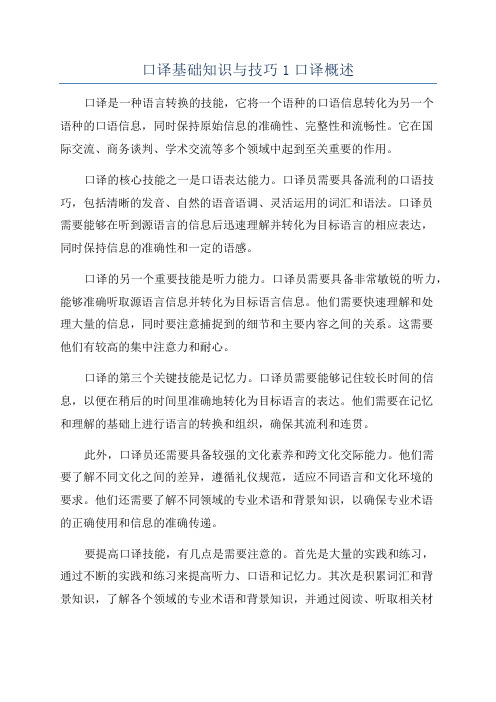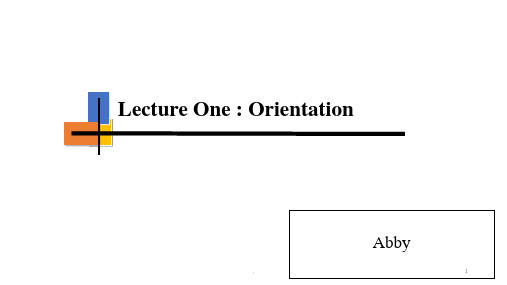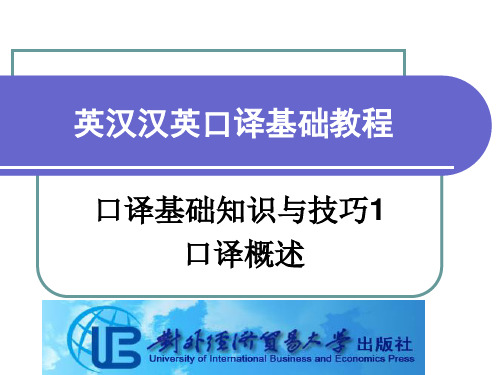Lecture1口译理论与技巧 第一讲
Lecture1-口译入门

精品资料
7、交替(jiāotì)传译 一般用于哪些场合?
交替传译除了广泛应用于国际会议之外, 也大量用于旅游观光、外交(wàijiāo)外事、 会晤谈判、商务活动、新闻传媒、培训授课、电 视广播、国际仲裁等诸多领域。
精品资料
8、合格的口译员需要具备哪些(nǎxiē)素质?
首先是两种工作语言的运用能力,特别是外语的听说能力,当 然也包括母语(mǔyǔ)的表达能力,双语语言能力是口译学习的基 础,但不一定要很高,只要适应工作需要就可以,不同的语言基础 的同学可以选择不同的学习目标。
精品资料
Websites for resources: 《口译天下(tiānxià)》学习网站 普特英语听力 / 沪江英语 /index.html ChinaDaily /chn/gxh/zlb/ 中国外交部网站“资料版” /index.shtml 中国商务部网站主页 / BBC英文主页 / New York Times主页 /world/ 新浪国际新闻中文版 / 《经济学人》英文主页 /home/uk Financial Times主页
上海外语口译证书考试 中、高级
口译演讲技巧[1]
![口译演讲技巧[1]](https://img.taocdn.com/s3/m/7039e004c77da26924c5b0bf.png)
PPT文档演模板
口译演讲技巧[1]
i. volume 音量
译员的声音听起来应该自然、亲切,音量适当; 过低或过高的音量会使听众觉得不舒服。
PPT文档演模板
口译演讲技巧[1]
ii. pitch 音调
译员应该音调适中; 但从始至终都是用同一音调也会使人感觉厌倦,因 此,应该根据工作场合和发言主题适当调整音量和 音调,使听众保持队发言的兴趣。
口译演讲技巧
PPT文档演模板
2020/11/14
口译演讲技巧[1]
Why public speaking skills are necessary in Interpreting?
In the process of Interpreting, interpreters are doing, to be frank, a kind of public speaking activity, therefore, the right public speaking skills are necessary and helpful for interpreters to complete the tasks.
•
演讲时速度快慢与声音大小也非常重要,但往往为人们所忽视。说话速度太快别人听起来吃力;说慢了又
让听众感到拖拖拉拉而失去了兴趣。同样,说话声音太大或离话筒太近,会使听众感到心烦意乱无法集中注意
力;反之,声音太小,听众听不清你说些什么精神也会溜号。
•
那么怎样把握说话速度与声音大小呢?要看演讲现场空间的大小。空间大,说话的速度就要稍慢一点,声
的注意力,而语调平淡则会催人入睡。
PPT文档演模板
口译演讲技巧[1]
• 举止打扮(manners and dressing)
翻译理论与技巧第一讲总论(课堂PPT)

——Thomas Huxley, Prolegomena to Evolution and Ethics.
可以有把握地想象,二千年前,在凯撒到达不列颠南部 之前,从我正在写作的屋子的窗口,可以看到整个原野 是处在一种所谓“自然状态”之中。
赫胥黎独处一室之中,在英伦之南,背山而面野,槛外 诸景,历历如在几下。乃悬想二千年前,当罗马大将凯 撒未到时,此间有何景物。计惟有天造草昧,人功未 施……
深奥才能达意,是复古的思想。核心是译作的文学价 值和艺术价值比较高。
13
It may be safely assumed that, two thousand years ago, before Caesar set foot in southern Britain, the whole countryside visible from the windows of the room in which I write, was in what is called “the state of Nature”.
洋学说和文学的做法,对他们惯用的“转述译法”提 出挑战,采用新的译法——忠实于原文的白话文的直 译法。
20
“易解”和“丰姿”的双标准: “力求易解”和“保存原作丰姿”:既要通顺、又要
忠实,是对“信达雅”的传承和发展。
“以直译为主,以意译为为辅” “以信为主,以顺为辅”
lecture_1__翻译概论

3) In terms of the media by which translation is done: oral, written and machine 从翻译的手段来分类,翻译可分为口译(oral interlingual translation)、笔译(written interlingual translation) 和机器翻译 (machine translation); 4) In terms of the subject matter: 从翻译的题材来分类,翻译可分为专业文献翻译(translation of English for science and technology)、文学翻译(literary translation)和一般性翻译(practical writing translation); 5)In terms of the manner: 从翻译的处理方式来分类,翻译可分为全译(full translation)、 摘译(partial translation)和编译(translation plus editing)。
E-C and C-E Translation Basics
英汉-汉英翻译基础
Lecture 1
Introduction to Translation
I. What is Translation?
1. A story of translation in Bible Long long ago, all the people speak the same language . When they transferred to the east, they found a plain and then lived there. They decided to build a tall tower, so that it can stretch to the heaven and they can live in the heaven. When Jesus saw this, he was afraid that if all the people speak the same language, they can do everything they want. So Jusus went down from the heaven and confused their languages so they couldn’t communicate with each other and they didn’t finish the Bable Tower. Since then, people lived in different places and spoke different languages. Hence comes the translation.
口译基础知识与技巧1口译概述

口译基础知识与技巧1口译概述口译是一种语言转换的技能,它将一个语种的口语信息转化为另一个语种的口语信息,同时保持原始信息的准确性、完整性和流畅性。
它在国际交流、商务谈判、学术交流等多个领域中起到至关重要的作用。
口译的核心技能之一是口语表达能力。
口译员需要具备流利的口语技巧,包括清晰的发音、自然的语音语调、灵活运用的词汇和语法。
口译员需要能够在听到源语言的信息后迅速理解并转化为目标语言的相应表达,同时保持信息的准确性和一定的语感。
口译的另一个重要技能是听力能力。
口译员需要具备非常敏锐的听力,能够准确听取源语言信息并转化为目标语言信息。
他们需要快速理解和处理大量的信息,同时要注意捕捉到的细节和主要内容之间的关系。
这需要他们有较高的集中注意力和耐心。
口译的第三个关键技能是记忆力。
口译员需要能够记住较长时间的信息,以便在稍后的时间里准确地转化为目标语言的表达。
他们需要在记忆和理解的基础上进行语言的转换和组织,确保其流利和连贯。
此外,口译员还需要具备较强的文化素养和跨文化交际能力。
他们需要了解不同文化之间的差异,遵循礼仪规范,适应不同语言和文化环境的要求。
他们还需要了解不同领域的专业术语和背景知识,以确保专业术语的正确使用和信息的准确传递。
要提高口译技能,有几点是需要注意的。
首先是大量的实践和练习,通过不断的实践和练习来提高听力、口语和记忆力。
其次是积累词汇和背景知识,了解各个领域的专业术语和背景知识,并通过阅读、听取相关材料来不断积累。
此外,要保持好奇心和求知欲,对各种话题保持兴趣,并持续学习和更新知识。
总的来说,口译是一项具有挑战性的工作,它需要口译员具备良好的口语表达能力、敏锐的听力、较强的记忆力和跨文化交际能力。
提高口译技能需要长时间的实践和练习,以及对各个领域的专业知识的积累。
只有不断努力和学习,口译员才能达到更高的水平,并为各个领域的交流做出更大的贡献。
英语口译基础教程Unit1Introdu

01
Introduction to Interpretation
Definition of Interpretation
It involves comprehending the exact meaning and intention of the source language and expressing it in the target language with accuracy and fluency
Executive Interpretation
The interpreter translates the spooked words of the source language after they have been delivered, either note taking or without notes
Standards for Interpretation
Accuracy
The interpreter must accurately translate the source language into the target language, ensuring that the meaning and intention are fully conveyed.
The interpreter needs to have a good memory to store and recall information during the interpretation process
Language conversion skills
Language comprehension
口译教程第一课PPT课件

1. Keyword identification
2. Keyword reduction
Ⅱ. Skills practice (40 min)
1. 2.2 Indentifying keywords
2. 2.3 Reducing keywords
Ⅲ.Interpreting exercises (80 min)
1)口译与笔译的异同:
相同点:都需要将一种语言经过理解和重组用另一种语言表达出来;
翻译者都必须精通两种语言、文化和转换技巧。
.
21
4. Characteristics of Interpreting (口译的特点)
The ability to understand and use spoken language
Understanding the theory underlying the principles and
practice of interpreting
Proficient in the skills and techniques which are used by
简称“同传”
讲话人的“说”与译员的“译”几乎同时进行。
同声传译可分为常规会议同传和耳语同传两种:
常规会议同传: regular conference SI
2-3人一组,在同传间/同传箱(booth)使用同传设备
一般译员每20分钟轮换一次
包括有稿同传和无稿同传两种形式
耳语同传: whispered interpreting or chuchotage
periods for Unit 5)
.
4
Unit Structure-Unit 1
一、技能讲解与训练 1.技能概述 2.听辨关键词 2.1技能讲解 2.2技能训练(1)关键词的选择 2.3技能训练(2)关键词的精简 3.辨识逻辑关系 3.1技能讲解 3.2技能训练(3)逻辑的纵向分析 3.3技能训练(4)逻辑的横向分析
口译基础知识与技巧1 口译概述

口译的标准为“快 (quick response) 、顺 (fluency)、准(faithfulness)
口译活动最重要的特点是语言、知识与技 巧三者的综合使用”(杨承淑2005:4)
译员的素质
译员必须熟练地驾驭源语和目的语,即英汉两 种语言,如语音语调地道、语法正确、用词准 确、语用知识恰当等。
英汉汉英口译基础教程
口译基础知识与技巧1 口译概述
按照口译的工作方式来分: ➢ 同声传译(simultaneous interpreting) ➢ 交替传译(consecutive interpreting) ➢ 视译(sight interpretation) ➢ 耳语式传译(whispered interpreting)
译员要是个“杂家”,不仅要具备一般人的常 识,而且要尽可能地熟悉了解各个领域的知识。
译员要具备翻译技巧,不译员要具备很强的身体和心理素质。 在口译学习中要特别注重实践练习。
- 1、下载文档前请自行甄别文档内容的完整性,平台不提供额外的编辑、内容补充、找答案等附加服务。
- 2、"仅部分预览"的文档,不可在线预览部分如存在完整性等问题,可反馈申请退款(可完整预览的文档不适用该条件!)。
- 3、如文档侵犯您的权益,请联系客服反馈,我们会尽快为您处理(人工客服工作时间:9:00-18:30)。
(外语与外语教学2015.4) 口译笔记认知与非英语专业学生交传质量相关性 • 王建华1 郭薇2 • (1,2. 中国人民大学外国语学院, 北京 100875)
• 摘要:本文以加涅的学习与记忆信息加工理论为基础,通过实证法考察口 译笔记认知训练对非英语专业学生交传口译质量的影响作用。本文对60名 被试进行为期5周的口译笔记认知训练,t检验和相关分析的结果表明:(1 )非英语专业学生口译笔记的符号与缩略语使用能力显著提高;(2)非英 语专业学生的口译笔记认知训练对口译准确性产生抑制作用,对流畅性产 生促进作用;(3)非英语专业学生在口译笔记认知训练初期对口译笔记有 强烈依赖性。本文以此提出口译与笔记教学的针对性建议:优先训练学生 无笔记复述能力;优先培养学生百科知识自我积累意识和语块生成能力; 重点训练学生应对多任务并行信息加工协调能力;重点提高学生笔记编码 连贯性和笔记解码能力。 • 关键词:口译笔记认知;非英语专业;交替传译 • 本文系国家社科基金项目:“语块教学策略对提高学生会议口译能力的实证 研究(11CYY026) "的部分成果。受中国人民大学外语学院“985工程”科研 基金品牌项目资助,项目号:2014Z004。 • 作者简介:王建华(1972-),副教授,博士,研究方向:语言心理学,口 译理论与实践 郭 薇(1989-),硕士,研究方向:翻译理论与实践
符号与 缩略 符号与缩略 语数 1 .590** .234 -.015 .003 -.362** .590** 1 .777** .261* .242 .066 .234 .777** 1 .461** .478** .320* -.015 .261* .461** 1 .913** .407** .003 .242 .478** .913** 1 .398** -.362** .066 .320* .407** .398** 1 笔记总数 单词正确数 意群正确数 流畅度
• 4. Encyclopedic Knowledge Inadequacy • A. technical knowledge • • B. cultural knowledge C. phonetic knowledge
Problems to Solve for interpreting
• • • • • • Input: 1. perception 2. prime 3.attention 4. decision-making 5. schema
(中国翻译2015.4) 元认知理论与交传口译的实证研究 • 王建华 中国人民大学
• 摘要:元认知即认知上再认知,强调自我意识和自我监控 ,交传口译教学的自我认知和自我体验性特点适合元认知 理论在其教学中的应用。通过元认知交替传译教学的实验 研究发现:经过一个半月的元认知教学,实验组学生在译 前准备,口译过程中的听力和理解水平以及口译课后的流 畅性表达评估三方面发生显著变化;经过三个月的元认知 教学,学生口译中的笔记和信息筛选及课后的口译准确性 、逻辑性、完整性评估均发生显著变化,相应能力显著提 高,p值远远小于.05。而控制组学生经过三个月学习后只 在听力、脑记和流畅性方面表现为边缘显著,p值接近.05 ,交传能力没有显著提高。 • 关键词:元认知 自我监控 交传口译
• • • • •
8:Chunk Theory 9: Evaluation Theory 10: Motivation Theory 11: Order-driven Theory in Simul 12. Theory of Generalization
II.Scholarly &Didactic Theories
• 2. Common challenges • A. accurate understanding • B. memory • C. coordination of efforts
• 3. Anxiety
• • A. being anxious previous to the task B. being anxious during the task
实验组和控制组第一次和第二次实验研究数据的 T检验结果对比
实验组元认知交替传译测评结果 元认知交替 传译三阶段 元 认 知 测 评指标 自评 T 检 验 (Sig) 课前口译准 备自我监控 百科知识 语言能力 听力 口译教学 过程指导 理解 脑记 笔记 信息筛选 准确性 课后评估与 反 思监控 流畅性 逻辑性 完整性 .001 .05 .008 .009 .05 .06 .05 .06 .02 .05 .05 他评 T 检 验 (Sig) .002 .04 .009 .008 .05 .04 .04 .05 .01 .05 .04 百科知识 语言能力 听力 理解 脑记 笔记 信息筛选 准确性 流畅性 逻辑性 完整性 控制组词汇教学测评数据 词汇教学测 评指标 自评 T检 验(Sig) .05 .02 .04 .05 .04 .06 .05 .06 .04 .05 .06 .04 .03 .04 .04 .04 .06 .05 .06 .04 .05 .05 他评 T检验(Sig)
5.1 实验数据的 t 检验 表 1: 训练前后被试的笔记认知和口译质量变化 t 检验 训练前 训练后 变量 符号与缩略语数 符号与缩略语占比 各类笔记总数 单词正确数 意群正确数 流畅度 均值
43.07 49.27 82.47 73.07 29.23 18.07
标准差
21.937 16.652 22.164 13.894 6.532 5.265
Output: 11.accuracy 12. fluency 13. logic
1. Theory of Sense
2. Gile Model
3. Cognitive Theory on Information Processing
4. Metacognitive Theory
• A. Pre-class Strategy • B. In-class Strategy • C. After-class Strategy
Common Features of Any form of Interpreting
• • • • • • • • • 1. Three basic steps A. Input---listening—audio+visual B. Information processing 1). Understanding 2). Memory C. Transformation 1). Transformation of form 2). Equivalence of information D. Output—speaking--audio
பைடு நூலகம்
均值
37.03 63.20 62.30 49.47 19.03 11.57
标准差
17.940 14.334 19.122 14.661 6.462 5.217
t值
1.166 -3.47 3.773 6.400 6.080 4.803
显著性
.248 .001 .000 .000 .000 .000
5.2.实验数据的 Pearson 相关检验 表 2:口译笔记认知与口译质量的Pearson相关性检验
变量
符号与缩略语占比 符号与缩略语数 笔记总数 单词正确数 意群正确数 流畅度
语占比
Types of Interpreting
• • • • • 1.Simul-interpreting 2. Consecutive Interpreting 3. Whisper 4. Sight-interpreting 5. Liaison Interpreting
• 1). Scholarly theories tend to be scientific theories • 2). Didactic theories tend to be empirical • 3). Data-based research
• 4). Experience-based research
• • • • • • •
Store of Information: 6. note 7. memory(working/short-term/long-term ) Transformation 8. equivalence in sense 9. target language generation 10. judge before output
5. Chunk Theory
6. Evaluation Theory
7. Motivation Theory
8. Memory Skills
9. Addition and Reducation Strategy
Lecture 1: Theories and Skills on Oral Interpretation
Jianhua Wang, an Associate Professor on Interpreting Studies School of Foreign Languages, Renmin University of China
I. Syllabus
• • • • • • • 1: General Introduction 2: Theory of Sense 3: Gile Model 4: Cognitive Theory 5: Metacognitive Theory 6: Memory Skills(1) 7: Memory Skills(2)
